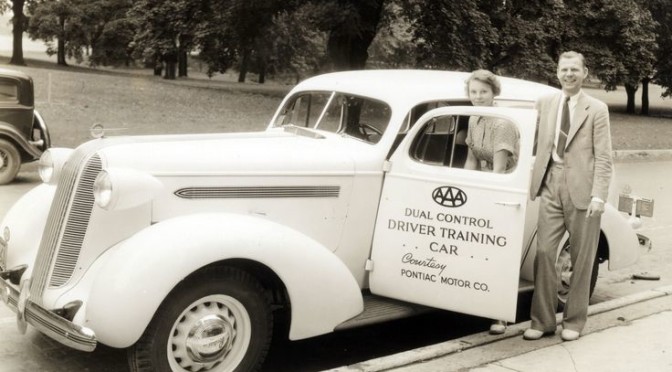The Research Institute at the Children’s Hospital of Philadelphia (CHOP) is looking for teens and adults diagnosed with autism spectrum disorder (ASD) to participate in a research study using virtual reality. Continue reading CHOP Looking for Participants for Virtual Reality Study
Category Archives: Research
Parents Teaching Distracted Driving Habits
“The learner should realize that every careless and inattentive act on his part, not only endangers his life, but the lives of his passengers, pedestrians, and occupants of other vehicles.”
That quote comes from Amos Neyhart, from his foundational 1934 work Instruction Book on the Safe Operation of a Motor Vehicle for Teachers and Learners. Neyhart, a professor at Penn State, originated the entire field of driver’s education. He taught students in the classroom and behind the wheel in his own car, a 1929 Graham-Paige. That particular car didn’t have a radio. Neyhart himself died in 1990, a decade before cell phones and GPS devices began to transform the inside of a car and really define what modern distractions are.
The words Neyhart published 78 years ago seem more prescient than anything from Nostradamus as modern cars and modern technology tempt us to distraction more every day. Distracted driving is one of the leading causes of today’s crashes and vehicle fatalities, and something we modern driving instructors must continually address.
Parents, you don’t seem to be helping as much as you could. According to a new survey by the University of Michigan Transportation Research Institute and Toyota, teens who think their parents drive distracted are 3 times as likely to drive distracted themselves. Remember, your kids start watching your driving behavior the moment you place them in a forward-facing car seat and get behind the wheel. Everything you do, they see, and children are wonderful mimics of parental behavior. Click here to read more about the new study.
Parents, take the time to go on a little inquest and take a strong, objective look at your driving behavior. If you can’t, have someone help you – solicit opinions from family and friends who often ride with you. If you’re not sure what behaviors to model for your children, why not give us a call? An hour with a professional instructor can reveal worlds about your driving, including dangerous habits you’re likely not even aware of yourself.
Driver education hasn’t changed much since the Neyhart days of the Great Depression. He recognized then that distracted drivers are dangerous drivers. What has changed is how very easily we can become distracted behind the wheel, and how much more dangerous we’ve become as drivers.
At Modern Driver Institute, we’re here to help ALL drivers, even the 87% of licensed Americans over the age of 30 who earned their driving privileges before cell phones existed and who are likely now training tomorrow’s drivers, just by modeling behaviors.
CDC Study Shows Changing Risks For Teens
Times, they are a’changing.
A new CDC survey of more than 15,000 high school students shows some interesting trends: the risky behaviors teens engage in behind the wheel are changing.
In 1991, 26% of teens admitted to “never or rarely” buckling up for a drive. Twenty years later, only 8% admit to the same risky behavior. That’s a terrific reduction, and it shows that the positive messages of driver education can make a difference. Likewise, the number of teens who admitted to either drinking while driving or riding with someone who had dropped by half. These two particular risks have plagued teens (and driving instructors) for the past 50 years, and finally seem to be on the decline – only to be replaced.
The new survey finds that a third of teens admit to texting while driving, and more teens now smoke pot than cigarettes, believing marijuana to be “safer” than tobacco.
Texting while driving is now illegal in Pennsylvania, but teens face only minor fines if they’re actually caught. Not all states treat the issue so lightly – Massachusetts recently convicted a teen of vehicular homicide for texting while driving. As for the rise in pot usage, blame an overly-aggressive anti-smoking campaign combined with a media spotlight on medical marijuana for confusing our kids. Whatever side of the cancer argument you might be on, no one questions that the active ingredients in marijuana impair safe driving ability. It’s hard to make that argument about tobacco.
There are more than 8 million licensed drivers in our state alone. The roads become more congested and more dangerous every year, and our teens are becoming more and more impaired, by technology and by materials they consume without understanding the dangers.
PARENTS, WHAT YOU CAN DO
Make sure that you have a Driving Contract with your newly licensed teen, and make sure that it explicitly forbids texting and marijuana use, in addition to forbidding drinking and other drugs. Have a talk with them about what marijuana can do to their mind, or have them talk with someone who knows. Install software on their phone which disables the ability to text while driving.
And keep up the seat belt messages – at least we’re getting through to them on that one.
Teen Driving Deaths On The Rise Again
WASHINGTON, D.C.—A report released today by the Governors Highway Safety Association (GHSA) reveals that the number of 16- and 17-year-old driver deaths in passenger vehicles increased dramatically for the first six months of 2012, based on preliminary data supplied by all 50 states and the District of Columbia. Overall, 16- and 17-year-old driver deaths increased from 202 to 240 – a 19 percent jump.
The new report – the first state-by-state look at teen driver fatalities in 2012 – was completed by Dr. Allan Williams, a researcher who formerly served as chief scientist at the Insurance Institute for Highway Safety. Dr. Williams surveyed GHSA members, who reported fatality numbers for every state and D.C. The increase in teen driver deaths coincides with a projection from the National Highway Traffic Safety Administration (NHTSA) in which all traffic deaths increased by 8 percent. It is particularly concerning that 16- and 17-year-old driver deaths appear to have increased at an even greater rate.
Deaths of 16-year-old drivers increased from 86 to 107 (a 24 percent change), while the number for 17-year-old drivers went from 116 to 133 (a 15 percent change), a cumulative increase of 19 percent. Twenty-five states reported increases, 17 had decreases, and eight states and the District of Columbia reported no change in the number of 16- and 17-year-old driver deaths.
Dr. Williams attributes much of the increase to the fact that the benefit of state Graduated Driver Licensing (GDL) laws may be leveling off, as most of these laws have been in place for some time. Additionally, Dr. Williams speculates that improving economic conditions are contributing to an increase in teen driving, thus increasing their exposure to risk. Dr. Williams notes, “Based on 2011 final data and the early look at 2012, it appears that we are headed the wrong direction when it comes to deaths of 16- and 17-year-old drivers.”
Dr. Williams stresses that while today’s news is certainly not good, deaths in this age group remain at a historically low level. He notes, “We are still at a much better place than we were ten or even five years earlier. However, the goal is to strive toward zero deaths, so our aim would be that these deaths should go down every year.”
Kendell Poole, Chairman of GHSA and Director of Tennessee’s Governor’s Highway Safety Office, said, “Any increase in highway deaths is unacceptable, particularly among our teens. We know from research and experience that teen drivers are not only a danger to themselves, but also a danger to others on the roadways. So these numbers are a cause for concern.” He continued, “As the report notes, a widespread strengthening of laws is still possible, and utilizing effective tools outside of GDL should be a focus. These include improving driver education and ensuring that scientifically based educational programs are available to new drivers.”
Chairman Poole added, “In my state of Tennessee, we have worked extensively to keep teen drivers safe. Despite our efforts, teens remain our most vulnerable population. With the advances in technology, we suspect distracted driving deaths among teen drivers are rising. We continue to work with teens, parents, educators and law enforcement to address this problem.”
Barbara Harsha, Executive Director of GHSA, stressed that while data are preliminary, she is concerned that signs point to a significant increase in 16- and-17-year-old driver deaths for 2012. She advises states to focus on strengthening GDL and programs that are data-driven. Harsha adds that states should consider implementing parent programs to help parents keep their teens safe. She says, “Parents have a huge responsibility to ensure safe teen driving behavior. States can facilitate this by providing innovative programs that bring parents and teens together around this issue.”
The full report, including state-by-state data, is available online at www.ghsa.org. Image files are also available.


